
Lunokhod was a series of Soviet robotic lunar rovers designed to land on the Moon between 1969 and 1977. Lunokhod 1 was the first roving remote-controlled robot to land on an extraterrestrial body.
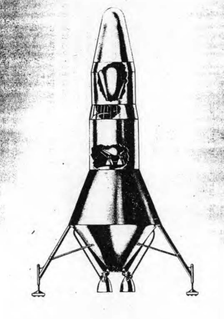
Project Horizon was a 1959 study to determine the feasibility of constructing a scientific / military base on the Moon, at a time when the U.S. Department of the Army, Department of the Navy, and Department of the Air Force had total responsibility for U.S. space program plans. On June 8, 1959, a group at the Army Ballistic Missile Agency (ABMA) produced for the Army a report titled Project Horizon, A U.S. Army Study for the Establishment of a Lunar Military Outpost. The project proposal states the requirements as:
The lunar outpost is required to develop and protect potential United States interests on the moon; to develop techniques in moon-based surveillance of the earth and space, in communications relay, and in operations on the surface of the moon; to serve as a base for exploration of the moon, for further exploration into space and for military operations on the moon if required; and to support scientific investigations on the moon.
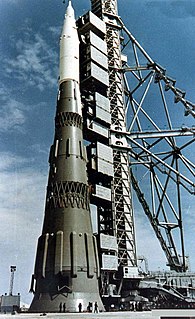
The N1/L3 was a super heavy-lift launch vehicle intended to deliver payloads beyond low Earth orbit. The N1 was the Soviet counterpart to the US Saturn V and was intended to enable crewed travel to Earth's Moon and beyond, with studies beginning as early as 1959. Its first stage remains one of the most powerful rocket stages ever built, However, all of the four flown N1 Block A first stages failed because a lack of static test firings meant that plumbing issues and other adverse characteristics with the large cluster of thirty engines and its complex fuel and oxidizer feeder system were not revealed earlier.

The Soviet space program was the national space program of the Union of Soviet Socialist Republics (USSR), conducted in competition with its Cold War adversary the United States, known as the Space Race from the mid-1950s until the dissolution of the Soviet Union in 1991.
The Soviet crewed lunar programs were a series of programs pursued by the Soviet Union to land humans on the Moon, in competition with the United States Apollo program to achieve the same goal set publicly by President John F. Kennedy on 25 May 1961. The Soviet government publicly denied participating in such a competition, but secretly pursued two programs in the 1960s: crewed lunar flyby missions using Soyuz 7K-L1 (Zond) spacecraft launched with the Proton-K rocket, and a crewed lunar landing using Soyuz 7K-LOK and LK spacecraft launched with the N1 rocket. Following the dual American successes of the first crewed lunar orbit on 24–25 December 1968 and the first Moon landing on July 20, 1969, and a series of catastrophic N1 failures, both Soviet programs were eventually brought to an end. The Proton-based Zond program was canceled in 1970, and the N1-L3 program was de facto terminated in 1974 and officially canceled in 1976. Details of both Soviet programs were kept secret until 1990 when the government allowed them to be published under the policy of glasnost.

TMK was the designation of a Soviet space exploration project to send a crewed flight to Mars and Venus without landing.

The physical exploration of the Moon began when Luna 2, a space probe launched by the Soviet Union, made an impact on the surface of the Moon on September 14, 1959. Prior to that the only available means of exploration had been observation from Earth. The invention of the optical telescope brought about the first leap in the quality of lunar observations. Galileo Galilei is generally credited as the first person to use a telescope for astronomical purposes; having made his own telescope in 1609, the mountains and craters on the lunar surface were among his first observations using it.
The Lunex Project was a US Air Force 1958 plan for a crewed lunar landing prior to the Apollo Program. The final lunar expedition plan in 1961 was for a 21-person underground Air Force base on the Moon by 1968 at a total cost of $7.5 billion. The primary distinction between the later Apollo missions and Lunex was the orbital rendezvous maneuver. The Lunex vehicle, composed of a landing module and a lifting body return/re-entry module, would land the entire vehicle and all astronauts on the surface, whereas the final Apollo mission involved a separate ascent module leaving the command module and service module connected in lunar orbit with a single astronaut. The original plan for Apollo was for direct ascent, similar to Lunex.

Mir-2 was a Soviet space station project which began in February 1976. Some of the modules built for Mir-2 have been incorporated into the International Space Station (ISS). The project underwent many changes, but was always based on the DOS-8 base block space station core module, built as a back-up to the DOS-7 base block used in the Mir station. The DOS-8 base block was eventually used as the Zvezda module of the ISS. Its design lineage extends back to the original Salyut stations.
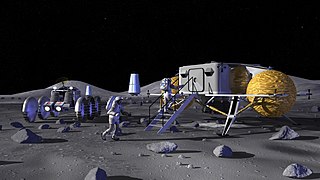
A lunar outpost is a concept of a permanent or semi-permanent presence of humans on the Moon, a moonbase, by the United States space administration NASA. NASA requested an increase in the 2020 budget of $1.6 billion, in order to make another crewed mission to the Moon by 2025, followed by a sustained presence on the Moon by 2028.

A moonbase is a facility on the surface of the Moon, enabling human activity at the Moon. As such it is different from a lunar space station in orbit around the Moon, like the planned Lunar Gateway of the Artemis program. Moonbases can be for uncrewed or crewed use, in both cases not necessarily including lunar habitation facilities. A base might be a step towards colonization.
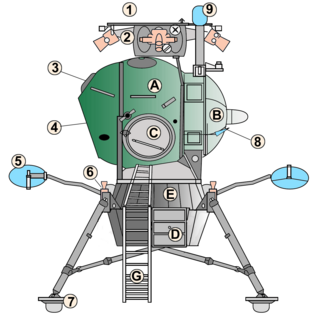
The LK was a lunar module developed in the 1960s as a part of several Soviet crewed lunar programs. Its role was analogous to the American Apollo Lunar Module (LM). Three LK modules, of the T2K variant, were flown without crew in Earth orbit, but no LK ever reached the Moon. The development of the N1 launch vehicle required for the lunar flight suffered setbacks, and the first Moon landings were achieved by US astronauts. As a result, both the N1 and the LK programs were cancelled without any further development.
In 1984, with the Space Shuttle in service, a team based at the Johnson Space Center made a feasibility study for NASA's return to the Moon. It anticipated later studies in using NASA's planned infrastructure – the Shuttle, a Shuttle-derived heavy lift vehicle, a space station, and an orbital transfer vehicle – to build a permanent 18-crew Moon base sometime between 2005 and 2015.
The Universal Rocket or UR family of missiles and carrier rockets is a Russian, previously Soviet rocket family. Intended to allow the same technology to be used in all Soviet rockets, the UR is produced by the Khrunichev State Research and Production Space Center. Several variants were originally planned, of which only three flew, and only two of which entered service. In addition, the cancelled UR-500 ICBM formed the basis for the Proton carrier rocket.

A suitport or suitlock is an alternative technology to an airlock, designed for use in hazardous environments and in human spaceflight, especially planetary surface exploration. Suitports present advantages over traditional airlocks in terms of mass, volume, and ability to mitigate contamination by—and of—the local environment.

The Russian Orbital Segment (ROS) is the name given to the components of the International Space Station (ISS) constructed in Russia and operated by the Russian Roscosmos. The ROS handles Guidance, Navigation, and Control for the entire Station.

A lunar rover or Moon rover is a space exploration vehicle designed to move across the surface of the Moon. The Apollo Program's Lunar Roving Vehicle was driven on the Moon by members of three American crews, Apollo 15, 16, and 17. Other rovers have been partially or fully autonomous robots, such as the Soviet Union's Lunokhods and the Chinese Yutus. Three countries have had operating rovers on the Moon: the Soviet Union, the United States and China. An Indian mission failed while Japan and Greece currently have planned missions.
Zvezda moonbase, also called DLB Lunar Base, was a Soviet plan and project from 1962 to 1974 to construct a crewed moonbase as successor to the N1-L3 human lunar expedition program. Zvezda moonbase was canceled with the rest of the Soviet human lunar programs.
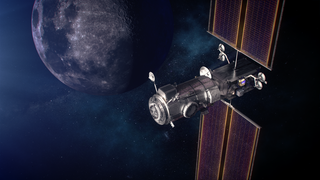
The Lunar Gateway, or simply Gateway, is a planned small space station in lunar orbit intended to serve as a solar-powered communication hub, science laboratory, short-term habitation module for government-agency astronauts, as well as a holding area for rovers and other robots. It is a multinational collaborative project involving four of the International Space Station partner agencies: NASA, European Space Agency (ESA), Japan Aerospace Exploration Agency (JAXA), and Canadian Space Agency (CSA). It is planned to be both the first space station in deep space and the first space station to orbit about the Moon.














